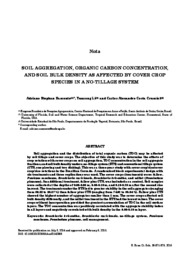Soil aggregation, organic carbon concentration, and soil bulk density as affected by cover crop species in a no-tillage system.
Soil aggregation, organic carbon concentration, and soil bulk density as affected by cover crop species in a no-tillage system.
Autoria: NASCENTE, A. S.; LI, Y.; CRUSCIOL, C. A. C.
Resumo: Soil aggregation and the distribution of total organic carbon (TOC) may be affected by soil tillage and cover crops. The objective of this study was to determine the effects of crop rotation with cover crops on soil aggregation, TOC concentration in the soil aggregate fractions, and soil bulk density under a no-tillage system (NTS) and conventional tillage system (CTS, one plowing and two disking). This was a three-year study with cover crop/rice/cover crop/rice rotations in the Brazilian Cerrado. A randomized block experimental design with six treatments and three replications was used. The cover crops (treatments) were: fallow, Panicum maximum, Brachiaria ruziziensis, Brachiaria brizantha, and millet (Pennisetum glaucum). An additional treatment, fallow plus CTS, was included as a control. Soil samples were collected at the depths of 0.00-0.05 m, 0.05-0.10 m, and 0.10-0.20 m after the second rice harvest. The treatments under the NTS led to greater stability in the soil aggregates (ranging from 86.33 to 95.37 %) than fallow plus CTS (ranging from 74.62 to 85.94 %). Fallow plus CTS showed the highest number of aggregates smaller than 2 mm. The cover crops affected soil bulk density differently, and the millet treatment in the NTS had the lowest values. The cover crops without incorporation provided the greatest accumulation of TOC in the soil surface layers. The TOC concentration was positively correlated with the aggregate stability index in all layers and negatively correlated with bulk density in the 0.00-0.10 m layer.
Ano de publicação: 2015
Tipo de publicação: Artigo de periódico
Unidade: Embrapa Arroz e Feijão
Palavras-chave: Brachiaria brizantha, Brachiaria ruziziensis, Manejo do solo, Panicum maximum, Pennisetum glaucum, Plantio direto
Observações
1 - Por padrão são exibidas publicações dos últimos 20 anos. Para encontrar publicações mais antigas, configure o filtro ano de publicação, colocando o ano a partir do qual você deseja encontrar publicações. O filtro está na coluna da esquerda na busca acima.
2 - Para ler algumas publicações da Embrapa (apenas as que estão em formato ePub), é necessário ter, no celular ou computador, um desses softwares gratuitos. Sistemas Android: Google Play Livros; IOS: iBooks; Windows e Linux: software Calibre.
Acesse outras publicações
Acesse a Base de Dados da Pesquisa Agropecuária (BDPA) para consultar o acervo completo das bibliotecas da Embrapa.

